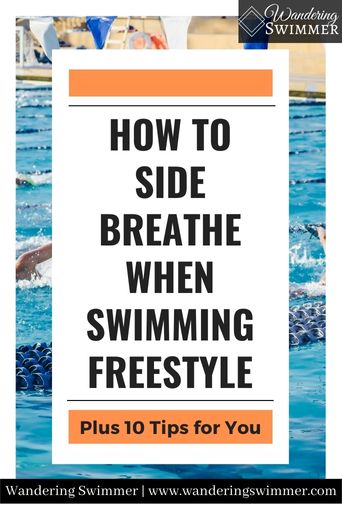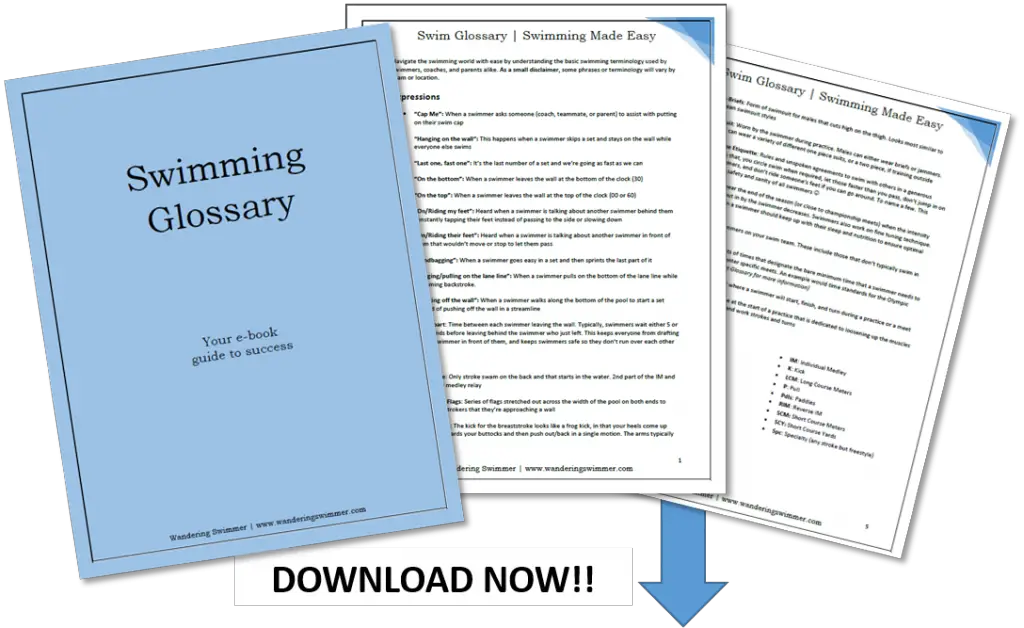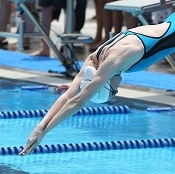Learning how to side breathe when swimming freestyle (aka the front crawl) takes some time and patience. But it is possible to learn on your own!
We will note that this isn’t something that can happen right away. Instead, you’ll need to keep practicing the motions and working some freestyle breathing drills to get it down.
To get you started, here’s our step-by-step guide on how to side breathe when swimming freestyle. Along with 10 breathing tips to help you succeed!
Disclosure: This post may contain affiliate links, meaning we earn a small commission at no cost to you if you purchase something through one of our links. As an Amazon Associate, we earn from qualifying purchases. Please check out our disclosure page for more information.

Why Should You Side Breathe in Freestyle?
It’s easier, more efficient, and more effective swimming!
In all seriousness, side breathing in freestyle (or the front crawl) is less of a strain on the neck and shoulders compared to lifting your head up and down to breathe. It’s also a much easier motion to do, as all you need to do is rotate your head and body to get your air.
Fast swimming comes from easy and efficient swimming. And if you want to improve your swimming or learn how to swim, learning to side breathe when swimming freestyle is a great first step.
Swim easier, not harder, and you’ll go farther! 🙂
Side Breathing Overview
Freestyle is the only stroke where you turn your head to breathe compared to lifting your head out of the water, such as in butterfly or breaststroke.
While you can turn your head to breathe in the butterfly (and sometimes breaststroke), it’s not as common for most swimmers.
Related article: 11 Ways to Improve Your Freestyle Kick
Side breathing in freestyle occurs during the stroke. Specifically when the one arm taking the stroke is pressing towards the hip in the water. This motion of the stroke can be called the stroke exit, upsweep, or exiting the water.
We will note that when you’re going to breathe, your body should roll/rotate more to the side that you’re breathing on compared to when you’re not breathing. This will help your body rotate more so that your face and mouth clear the water so you can breathe.
For drills to help you learn how to side breathe when swimming freestyle, be sure to read our companion article: 7 Drills to Practice Side Breathing in Freestyle
Step by Step: How to Breathe When Swimming Freestyle
In this step-by-step example, we’ll review how to side breathe to the right side in freestyle. If you prefer or want to try breathing to the left, you can still follow this guide. Simply do the opposite 🙂
- Start to roll/rotate your body to the left side before you get ready to side-breathe. This will get the right side of your body facing more to the side so you can breathe easier
- The best time to start your rotation is when your right hand/arm is pushing from your torso down to the hip. Starting your rotation during the movement will give your body the propulsion to roll easier and rotate your head
- As your right hand is pushing past your right hip, your left hand should be extended in front of you and entering (or almost entering the water)
- At the same time as your right hand is going past your hip, your head should be rotated to the side to breathe
- Once your face clears the water, take your breath
- Continue your stroke with your right arm as you’re taking your breath
- As your left hand is pushing from your torso down to your hip, rotate your head and shoulder back into the water. Your right hand will almost be ready to enter the water
1. Getting Ready to Breathe
When you’re ready to take your side breath in freestyle, you need to know which side you’ll breathe to before taking your breath. For some, they can breathe to either side. Others can only breathe to one side.
Based on your ability and preference, you’ll either need to take another stroke before breathing. Or, you can take your side breath on the upcoming stroke.
2. Rotation
The freestyle stroke is a continuous motion. So that when one arm is extended over the water, the opposite arm should be almost extended behind you. This helps with propulsion and rotation, helping you move forward and breathe.
Start your rotation as the hand underwater is pushing from your chest and down toward your hip. Beginning your rotation during this motion gives you the oomph to help roll your shoulder and head out of the water.
More Content for You: 10 Things You Should Be Doing After a Swim Workout (But Aren’t)
3. When to Breathe
Probably the most difficult part of learning how to side-breathe when swimming freestyle is getting the timing right. Breathe too early or late and you get more water than air in your mouth!
You should be breathing to the side at about the time your hand is just by your hip. Some swimmers can breathe when their hand is leaving the water but it’s easier to start breathing when your hand is at your hip.
Your opposite hand and arm will be stretched out in front of you. Your hand will either be just getting ready to enter the water or may be entering the water.
4. Recovery
The part of the stroke that’s up and over the water is called ‘the recovery’. It’s at this stage of your freestyle stroke that you’ll finish getting your air and start to rotate your head and shoulder back into the water.
As your hand and arm are swinging over the water, the motion should naturally help you rotate back into the water.
More Content for You: How Many Calories Does Swimming Burn?
At the same time that you’re rotating back to put your face in the water, your opposite hand will be pushing down from your torso to your hip. Just as your current hand was doing before taking your side breath.
Remember that the stroke in freestyle is a continuous movement and almost an opposite mirror of each arm. They stretch out and forward at the same time, and pass each other on the recovery and upsweep.
5. Finish the Stroke
By the time your hand is entering the water again, your face and shoulders should be back in the water. And your body should be facing the bottom of the pool.
You now know how to side breathe when swimming freestyle!
Of course, it’s much easier to read and practice on land than in the water. It does take time and it’s much easier to start slowly until you become accustomed to the side breath.
However, don’t give up after a few laps. Instead, stop each time you get to the wall to catch your breath and recenter yourself. Do some strokes standing to get the motion before starting again.
More Content for You: Basic Pool Etiquette: 15 Ways to Share the Pool
10 Freestyle (or Front Crawl) Breathing Tips
1. Breathe Out First
It may seem counterintuitive, but before you start to rotate your body to get your air, you need to start exhaling and breathing out. This will force out the remaining air in your lungs and allow you to get the air you need to continue swimming.
The motion of side breathing is so quick that you don’t have time to exhale all your air and inhale in one motion.
Because of this, you must start exhaling a stroke or two before you take your stroke to get air. Doing this will allow you to get the air you need. And it can help prevent getting water up your nose.
Related article: Why is Swimming So Hard?
2. One Goggle When You Breathe
Admittedly, when you’re first starting to learn how to side breathe when swimming freestyle, it’s tempting to roll your entire face out of the water. However, doing this throws off your body’s balance.
Your hips can sink, you either stop kicking or begin to kick harder, and your arms flail around.
Instead, try to rotate your head just enough so that only one eye and your nose clear the water’s surface. You’ll need to contort your lips and mouth some to maximize the most of your air. And yes, it’ll look funny at times, but you’re not swimming for the looks of it 😉
3. Avoid Armpit Breathing
When breathing to the side, don’t duck your head down and breathe back into your armpit. Doing this forces your head out of balance, which can make your stroke wonky.
You’re also more likely to get water up your nose or choke on water, as your body makes more waves in that area as it cuts through the water.
4. Don’t Look Forward
At the same time, don’t look forward when you’re side breathing. Some swimmers will tilt their heads up and then rotate them to the side.
While this can work, you’re more likely to hurt or exhaust your neck muscles. And it takes more effort and time to get your breath compared to simply turning your head to the side.
More Content for You: How to Fix Common Swim Goggle Problems
It can also cause your body to fall out of balance. Your hips will drop and most swimmers will either stop kicking and stroke harder or they’ll try to kick harder.
The problem with this is that they’re not addressing the lost balance and kicking or stroking harder only leads to exhaustion. This type of swimming also doesn’t get you very far. You’re working harder with no reward.
5. Rotate to Breathe
When you’re breathing, it’s more than just turning your head to the side. You also need to rotate your body as you’re turning your head. It’s more of the turning of your shoulders and hips that will turn your head!
Your shoulders and hips should start the rotation to the side when you side breathe in freestyle. From there, the neck and head will follow the motion.
Rotating your body to breathe instead of just turning your head to the side makes for an easier stroke. It also makes it easier to get your breath of air.
6. Exhale Before Breathing
The recovery portion of the freestyle stroke, which is the moment when you should be breathing, is too fast to exhale and inhale. You’ll only have enough time to do one but not both.
Instead, it’s important that you exhale your air before you start to take your stroke to breathe.
Doing this will clear out the remaining air in your lungs and allow you to inhale just as you’re rotating to breathe.
More Content for You: 6 Best Earplugs for Swimming
7. Nose vs Mouth Exhaling
On the subject of exhaling before breathing! You can either exhale your air through your nose and/or mouth or just through your nose.
This comes down to preference and what you feel exhales the most air before you go to breathe.
You’ll force out more air through your mouth compared to your nose. But blowing some bubbles from your nose also helps keep water from getting water up your nose. I favor both but exhale more from my nose.
8. Holding Breath vs Continuous Exhalation
This tip varies by the swimmer. Some swimmers like to exhale slowly while they’re swimming and then go to breathe when they need air again. Other swimmers will hold their breath while swimming and then start to exhale their air as they’re turning to breathe.
I fall into the latter group and hold my breath until I know I need air. But I know of others who continuously exhale. And there’s debate as to which is the better option.
Related article: Make Learning to Swim Your New Year’s Resolution
Truthfully, we recommend whatever feels easier and more natural for you. If you’re going to hold your breath though, you shouldn’t go many strokes in a row without getting air. Oxygen deprivation is real and passing out in the water can lead to drowning.
Establish a breathing pattern to avoid going too long without air. Try breathing every 2-5 strokes to find a number that works best for you.
9. Inhale Through the Mouth
It should seem obvious but when you’re breathing, take your breath through your mouth compared to your nose.
You’ll get the most air through your mouth when you go to breathe. This will give you enough oxygen to keep swimming for several more strokes.
If you breathe in through your nose though, you’re more likely to inhale water up your nose. You’ll also get a much smaller amount of oxygen.
10. Blow Bubbles
When it comes time to breathe, blow bubbles! We’ve said it before but blowing bubbles through your nose will help keep water from going up it instead. It doesn’t need to be a forceful gust from your nose either. A simple exhale from your nose is enough.
Do this before you breathe and as you’re turning your head. You’ll want to do this as you’re turning your head to breathe and as you’re rotating back into the water.
More Content for You: Your Complete Guide to Swim Lessons for Adults
Types of Breathing Patterns
Breathing patterns are the patterns that you breathe when swimming. Such as taking a breath for every five strokes you take. Or breathing every stroke. Every swimmer will have their own breathing pattern that fits them.
In freestyle, these breathing patterns fall into two categories: bi-lateral and unilateral.
Bi-Lateral Breathing
Bi-lateral breathing occurs when you can breathe to both sides of your stroke, or on the odd number of strokes. Such as strokes 3, 5, or 7,
This type of breathing is well balanced, as you breathe to both sides equally (or close to equally) and one side doesn’t get stronger than the other.
In competitive swimming, this gives swimmers an advantage because they can see both sides of them while racing. It can help them gauge who is close behind them or just in front.
More Content for You: 8 Reasons Your Swim Cap Slides Off
This is my preferred breathing pattern, although I do breathe more to my right side than my left. However, three years ago, I favored my left side more! We say this because as your stroke grows and develops, you may find that one side is easier to breathe on than the other 🙂
Unilateral Breathing
Compared to bi-lateral breathing, unilateral breathing focuses on breathing only to one side, or the even number of strokes.
This is a great breathing style for those who can only breathe to one side when swimming freestyle. It takes less effort for some because your breathing pattern is always on the same side.
Breathing to the same side can cause your stroke to become unbalanced though. And you risk more shoulder injury on your breathing arm compared to bi-lateral breathing.
Breathing Every Stroke
While this seems tempting to breathe every stroke, we don’t recommend it. It’s exhausting to keep rotating so much to get a breath for every stroke. It can also make you dizzy because you’re constantly moving your head.
Instead, you’re better off trying to breathe every two strokes to give yourself some break.
More Content for You: Best Lap Swimsuits for Women
In Closing
Learning how to side breathe when swimming freestyle takes time, we won’t lie. It’s not something that happens overnight or even within a week. It can take a while to get the motion and pattern down.
However, you shouldn’t let that stop you from trying to learn. Side breathing in freestyle is a far more efficient way to swim freestyle. Your muscles will thank you and you’ll find yourself getting in more laps than ever before!
As always, happy swimming!
Chevron
Bonus Content
Swimming Basics to Get You Started: A brief overview of some basic swimming topics to help you get started. All the information you’ll need on swimming basics in one quick glance. And hopefully, they’ll help you answer the questions that you might have.
Basic Swimming Terminology: Knowing some swimming terminology, or swim terms, will help you navigate the swimming world. Here are 25 common swimming terms to get you started.

Want to Improve at the Pool?
Join swimmers and swim parents to receive my free newsletter and receive a free Swimming Glossary e-book as a thanks!
Every month you’ll receive tips and coaching to help you find success at the pool.
About

Chevron is a current competitive swimmer with almost 20 years of experience in the pool. And although she fell into the sport by accident in her high school years, she still trains daily and competes throughout the year. She’s committed to providing guidance to all levels of swimmers and believes that everyone should know how to swim.